Rural Poverty Identification and Comprehensive Poverty Assessment Based on Quality-of-Life: The Case of Gansu Province (China)
Abstract
1. Introduction
2. Overview of Study Region
3. Data Sources and Research Methods
3.1. Data Sources and Preprocessing
3.2. Research Methods
3.2.1. Assessing QRL
3.2.2. Assessing Relative Poverty
3.2.3. Spatial Variation Measurement
3.2.4. Importance–Performance Analysis
3.2.5. Comprehensive Poverty Level
4. Results
4.1. Spatial Variation of QRL and Relative Poverty
4.1.1. SPATIAL Variation of QRL
4.1.2. Spatial Variation of Relative Poverty
4.2. Identification of Poverty Objects
4.3. Comprehensive Poverty Level
5. Discussion
6. Conclusions
Author Contributions
Funding
Conflicts of Interest
References
- Wang, X.L.; Sabina, A. Measurement of multiple-dimensional poverty in China: Evaluation and policy implication. Chin. Rural Econ. 2009, 12, 4–10. [Google Scholar]
- Mokomane, Z.; Mokhele, T.; Mathews, C.; Makoae, M. Availability and accessibility of public health services for adolescents and young p eople in south africa. Child. Youth Serv. Rev. 2017, 74, 125–132. [Google Scholar] [CrossRef]
- World Bank Group. Poverty and shared prosperity2016, taking on inequity. In Poverty and Shared Prosperity Series; World Bank Group: Washington, DC, USA, 2015. [Google Scholar]
- Sapena, J.; Almenar, V.; Apetrei, A.; Escrivá, M.; Gil, M. Some reflections on poverty eradication, true development and sustainability within cst. J. Innov. Knowl. 2018, 3, 90–92. [Google Scholar] [CrossRef]
- Ramírez, J.M.; Díaz, Y.; Bedoya, J.G. Property tax revenues and multidimensional poverty reduction in colombia: A spatial approach. World Dev. 2017, 94, 406–421. [Google Scholar] [CrossRef]
- Tonmoy Islam, T.M. An exercise to evaluate an anti-poverty program with multiple outcomes using program evaluation. Econ. Lett. 2014, 122, 365–369. [Google Scholar] [CrossRef]
- Wenlue, W.; Qian, R.; Jin, Y. Impact of the ecological resettlement program on participating decision and poverty reduction in southern shaanxi, china. For. Policy Econ. 2018, 95, 1–9. [Google Scholar]
- Alkire, S.; Apablaza, M.; Chakravarty, S.; Yalonetzky, G. Measuring chronic multidimensional poverty. J. Policy Model. 2017, 39, 983–1006. [Google Scholar] [CrossRef]
- Pasha, A. Regional perspectives on the multidimensional poverty index. World Dev. 2017, 94, 268–285. [Google Scholar] [CrossRef]
- Alkire, S.; Roche, J.M.; Vaz, A. Changes over time in multidimensional poverty: Methodology and results for 34 countries. World Dev. 2017, 94, 232–249. [Google Scholar] [CrossRef]
- Alkire, S.; Seth, S. Multidimensional poverty reduction in india between 1999 and 2006: Where and how? World Dev. 2015, 72, 93–108. [Google Scholar] [CrossRef]
- Liu, Y.; Liu, J.L.; Zhou, Y. Spatio-temporal patterns of rural poverty in China and targeted poverty alleviation strategies. J. Rural Stud. 2017, 52, 66–75. [Google Scholar] [CrossRef]
- Guo, Y.Z.; Zhou, Y.; Liu, Y.S. Targeted poverty alleviation and its practices in rural China: A case study of Fuping county, Hebei Province. J. Rural Stud. Corrected Proof (In Press). [CrossRef]
- Li, E.L.; Deng, Q.Q.; Zhou, Y. Livelihood resilience and the generative mechanism of rural households out of poverty: An empirical analysis from Lankao County, Henan Province, China. J. Rural Stud. Corrected Proof (In Press). [CrossRef]
- Zhang, Y.; Zhou, X.; Lei, W. Social capital and its contingent value in poverty reduction: Evidence from western china. World Dev. 2017, 93, 350–361. [Google Scholar] [CrossRef]
- Chen, M.X.; Sui, Y.W.; Liu, W.D.; Liu, H.; Huang, Y.H. Urbanization patterns and poverty reduction: A new perspective to explore the countries along the Belt and Road. Habitat Int. 2019, 84, 1–14. [Google Scholar] [CrossRef]
- Martin, R. On testing the scale sensitivity of poverty measures. Econ. Lett. 2015, 137, 88–90. [Google Scholar]
- Filippo, D.; Francesca, C.; Sabrina, G. A new formulation of the dagum distribution in terms of income inequality and poverty measures. Physica A 2018, 511, 104–126. [Google Scholar]
- Alkire, S.; Santos, M.E. Acute multidimensional poverty: A new index for developing countries. Equity Health Human Dev. 2011, 38. [Google Scholar] [CrossRef]
- Huang, H.; Liu, S.Q.; Cui, X.X.; Zhang, J.F.; Wu, H. Factors associated with quality-of-life among married women in rural china: A cross-sectional study. Qual. Life Res. 2018, 27, 3255–3263. [Google Scholar] [CrossRef] [PubMed]
- Janmaimool, P.; Denpaiboon, C. Rural villagers’ quality-of-life improvement by economic self-reliance practices and trust in the philosophy of sufficiency economy. Societies 2016, 6, 26. [Google Scholar] [CrossRef]
- Tran, T.Q.; Nguyen, C.V.; Van Vu, H. Does economic inequality affect the quality-of-life of older people in rural vietnam? J. Happiness Stud. 2017, 19, 781–799. [Google Scholar] [CrossRef]
- Bi, A.P. Research Progresses of Rural Regional-System Degradation. Chin. Agric. Sci. Bull. 2014, 30, 112–116. [Google Scholar]
- Li, H.B.; Zhang, X.L. Spatial Extension in the Context of Urban and Rural Development: Village Recession and Reconstruction. Reform 2012, 1, 148–153. [Google Scholar]
- Watson, P.; Deller, S. Economic diversity, unemployment and the great recession. Q. Rev. Econ. Financ. 2017, 64, 1–11. [Google Scholar] [CrossRef]
- Yang, Z.; Jiang, Q.; Liu, H.M.; Wang, X.X. Multi-Dimensional Poverty Measure and Spatial Pattern of China’s Rural Residents. Econ. Geogr. 2015, 35, 148–153. [Google Scholar]
- Wang, X.W.; He, M.H.; Li, Y.J. Re-selection of Poverty Alleviation Model Based on the Perspective of Spatial Poverty—Taking Gansu as an Example. Gansu Soc. Sci. 2012, 6, 95–98. [Google Scholar]
- Xinhua News Agency. Fan Xiaojian, Director of the State Council Office of Poverty Alleviation, Explained the New Standard of Poverty Alleviation of 2,300 yuan. Available online: Http://www.gov.cn/jrzg/2011-12/02/content_2009471.htm (accessed on 28 July 2019).
- Gansu Provincial Poverty Alleviation and Development Office. List of Poor Counties in Gansu Province. Available online: http://fpb.gansu.gov.cn/helpnews/viewnews-14405.html (accessed on 28 July 2019).
- Gansu Development Yearbook Editorial Board. Gansu Province Development Yearbook 2017; China Statistics Press: Beijing, China, 2017.
- Sun, H.W.; Lv, C.H.Y.; Qi, A.G.; Cao, G.H.; Han, C.H.L. Research on the principles of data standardization in comprehensive evaluation. Chin. J. Health Stat. 2015, 32, 342–344. [Google Scholar]
- Liu, J.Y.; Zhang, K.; Wang, G.H. Comparative Study on data standardization methods in comprehensive evaluation. Digit. Technol. Appl. 2018, 36, 84–85. [Google Scholar]
- Bianca, B.; Maria, G.L.; Marta, M. Urban Quality-of-life and Capabilities: An Experimental Study. Ecol. Econ. 2018, 150, 137–152. [Google Scholar]
- Sirgy, M.J.; Terri, C. How neighborhood features affect quality-of-life. Soc. Indic. Res. 2002, 59, 79–114. [Google Scholar] [CrossRef]
- Robert, C.; Brendan, F.; Saleem, A. Quality-of-life: An approach integrating opportunities, human needs, and subjective well-being. Ecol. Econ. 2007, 61, 267–276. [Google Scholar]
- Zhou, G.H.; Liu, C.; Tang, C.L.; He, Y.H.; Wu, J.M.; He, L. Spatial pattern and influencing factors of quality-of-life in rural areas of Hunan province. Geogr. Res. 2019, 37, 2475–2489. [Google Scholar]
- Zhong, S.X.; Hu, P.; Xue, X.M.; Yang, S.; Zhu, P.J. Multi-factor comprehensive evaluation model based on the selection of objective weight assignment method. Acta Geogr. Sin 2015, 70, 2011–2031. [Google Scholar]
- Ministry of Finance of the People’s Republic of China. Central Financial Special Poverty Alleviation Fund Management Measures. Available online: http://fgk.mof.gov.cn/law/getOneLawInfoAction.do?law_id=84519 (accessed on 13 March 2017).
- Pan, J.H.; Hu, Y.X. Spatial Identification of Multidimensional Poverty in China Based on Nighttime Light Remote Sensing Data. Econ. Geogr. 2016, 36, 124–131. [Google Scholar]
- Chen, Y.B.; Zheng, Z.H.; Wu, Z.F.; Qian, Q.L. Review and prospect of application of nighttime light remote sensing data. Prog. Geogr. 2019, 38, 205–223. [Google Scholar]
- Yu, B.; Che, S.; Xie, C.; Tian, S. Understanding Shanghai Residents’ Perception of Leisure Impact and Experience Satisfaction of Urban Community Parks: An Integrated and IPA Method. Sustainability 2018, 10, 1067. [Google Scholar] [CrossRef]
- Deng, J.; Pierskalla, C.D. Linking Importance–Performance Analysis, Satisfaction, and Loyalty: A Study of Savannah. GA. Sustainability 2018, 10, 704. [Google Scholar] [CrossRef]
- Wang, X.Y.; Zhu, W.L. Study on the identification of poverty—Stricken areas and the development potential of rural tourism in southern shandong province. Chin. J. Agric. Resour. Reg. Plan. 2018, 39, 269–275. [Google Scholar]
- Huang, Y.Y. Environmental risks and opportunities for countries along the Belt and Road: Location choice of China’s investment. J. Clean. Product. 2019, 21, 14–26. [Google Scholar] [CrossRef]
- Zhou, Y.; Guo, Y.Z.; Liu, Y.S. Comprehensive measurement of county poverty and anti-poverty targeting after 2020 in China. Acta Geogr. Sin 2018, 73, 1478–1493. [Google Scholar]
- Eskildsen, J.K.; Kristensen, K. Enhancing importance–Performance analysis. Int. J. Product. Perform. Manag 2006, 55, 40–60. [Google Scholar] [CrossRef]
- Deng, W.J. Using a revised importance–Performance analysis approach: The case of Taiwanese hot springs tourism. Tour. Manag. 2007, 28, 1274–1284. [Google Scholar] [CrossRef]
- Liu, Y.; Xu, Y. A geographic identification of multidimensional poverty in rural china under the framework of sustainable livelihoods analysis. Appl. Geogr. 2016, 73, 62–76. [Google Scholar] [CrossRef]
- Maleček, P.; Čermáková, K. In-work poverty in the czech republic: Identification of the most vulnerable groups. Proced. Econ. Financ. 2015, 30, 566–572. [Google Scholar] [CrossRef]
- Glauben, T.; Herzfeld, T.; Rozelle, S.; Wang, X. Persistent poverty in rural china: Where, why, and how to escape? World Dev. (Oxf.) 2012, 40, 784–795. [Google Scholar] [CrossRef]
- Drèze, J.; Srinivasan, P.V. Widowhood and poverty in rural india: Some inferences from household survey data. J. Dev. Econ. 1995, 54, 217–234. [Google Scholar] [CrossRef]
- Gazeley, I.; Verdon, N. The first poverty line? Davies’and eden’s investigation of rural poverty in the late 18th-century england. Explor. Econ. Hist. 2014, 51, 94–108. [Google Scholar] [CrossRef]
- Liang, Z.X.; Hui, T.K. Residents’ quality-of-life and attitudes toward tourism development in china. Tour. Manag. 2016, 57, 56–67. [Google Scholar] [CrossRef]
- Martilla, J.A.; James, J.C. Importance–Performance analysis. J. Mark. 1997, 41, 77–79. [Google Scholar] [CrossRef]
- Wu, X.Y.; Qi, X.H.; Yang, S.; Ye, C.; Sun, B. Research on the Intergenerational Transmission of Poverty in Rural China Based on Sustainable Livelihood Analysis Framework: A Case Study of Six Poverty-Stricken Counties. Sustainability 2019, 11, 2341. [Google Scholar] [CrossRef]
- Ministry of Finance of the People’s Republic of China. Notice on Printing and Distributing the Measures for the Administration of Special Funds for Poverty Alleviation by Finance (2011–2016). Available online: http://www.gov.cn/gzdt/2011-11/29/content_2006260.Htm (accessed on 10 March 2019).
- Yang, R.; Wen, Q.; Wang, C.; Du, G.M.; Li, B.H.; Qu, Y.B.; Li, H.B.; Xu, J.W.; He, Y.H.; Ma, L.B.; et al. Discussions and thoughts of the path to China’s rural revitalization in the new era: Notes of the young rural geography scholars. J. Nat. Resour. 2019, 34, 890–910. [Google Scholar]
- Liu, Y.S.; Guo, Y.; Zhou, Y. Poverty alleviation in rural China: Policy changes, future challenges and policy implications. China Agric. Econ. Rev. 2018, 10, 241–259. [Google Scholar] [CrossRef]
- Yang, Z.; Guo, Y.; Liu, Y.; Wu, W.; Li, Y. Targeted poverty alleviation and land policy innovation: Some practice and policy implications from china. Land Use Policy 2018, 74, 53–65. [Google Scholar]
- Chen, J.; Wang, Y.; Wen, J.; Fang, F.; Song, M. The influences of aging population and economic growth on chinese rural poverty. J. Rural Stud. 2016, 47, 665–676. [Google Scholar] [CrossRef]
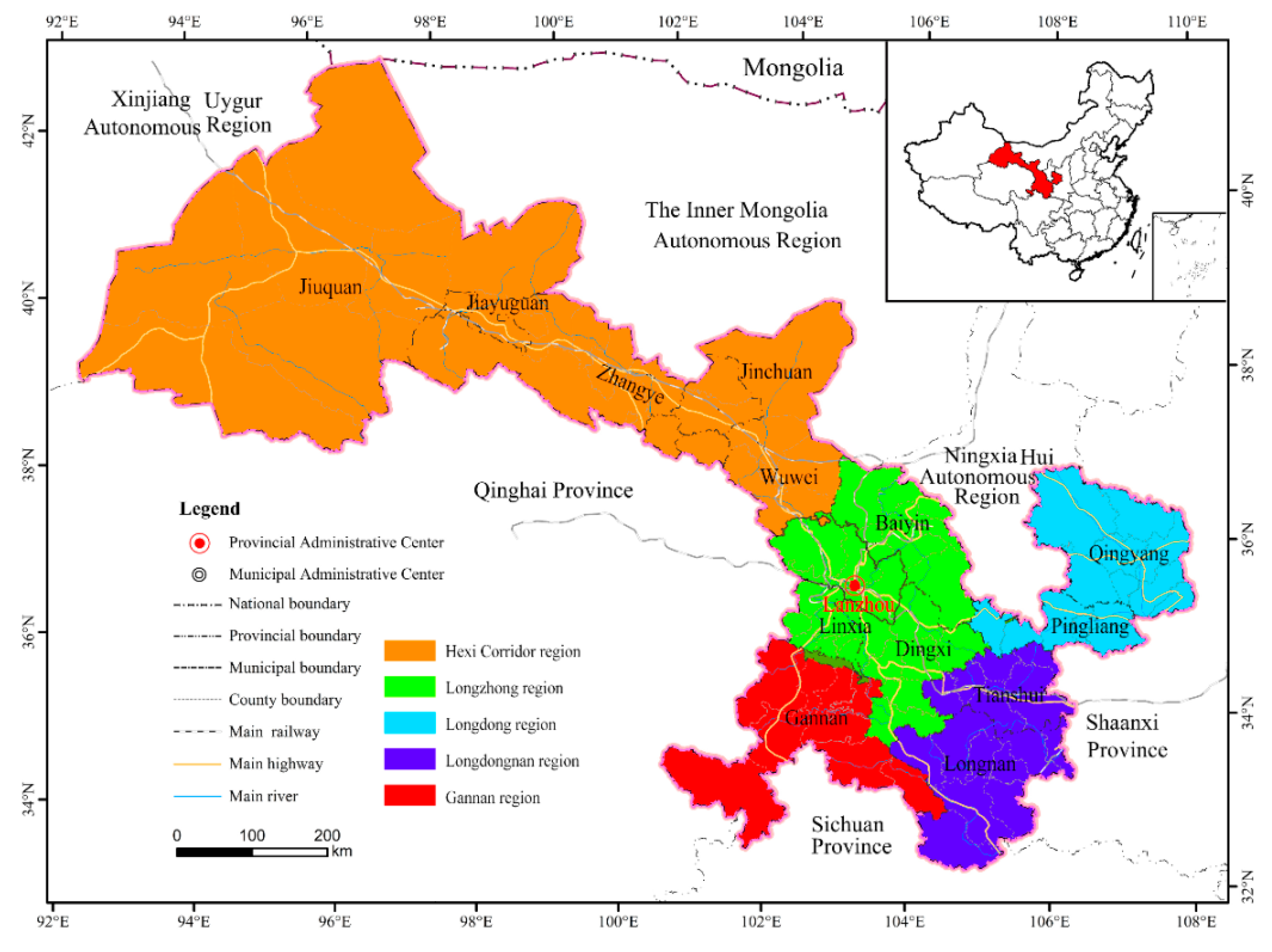
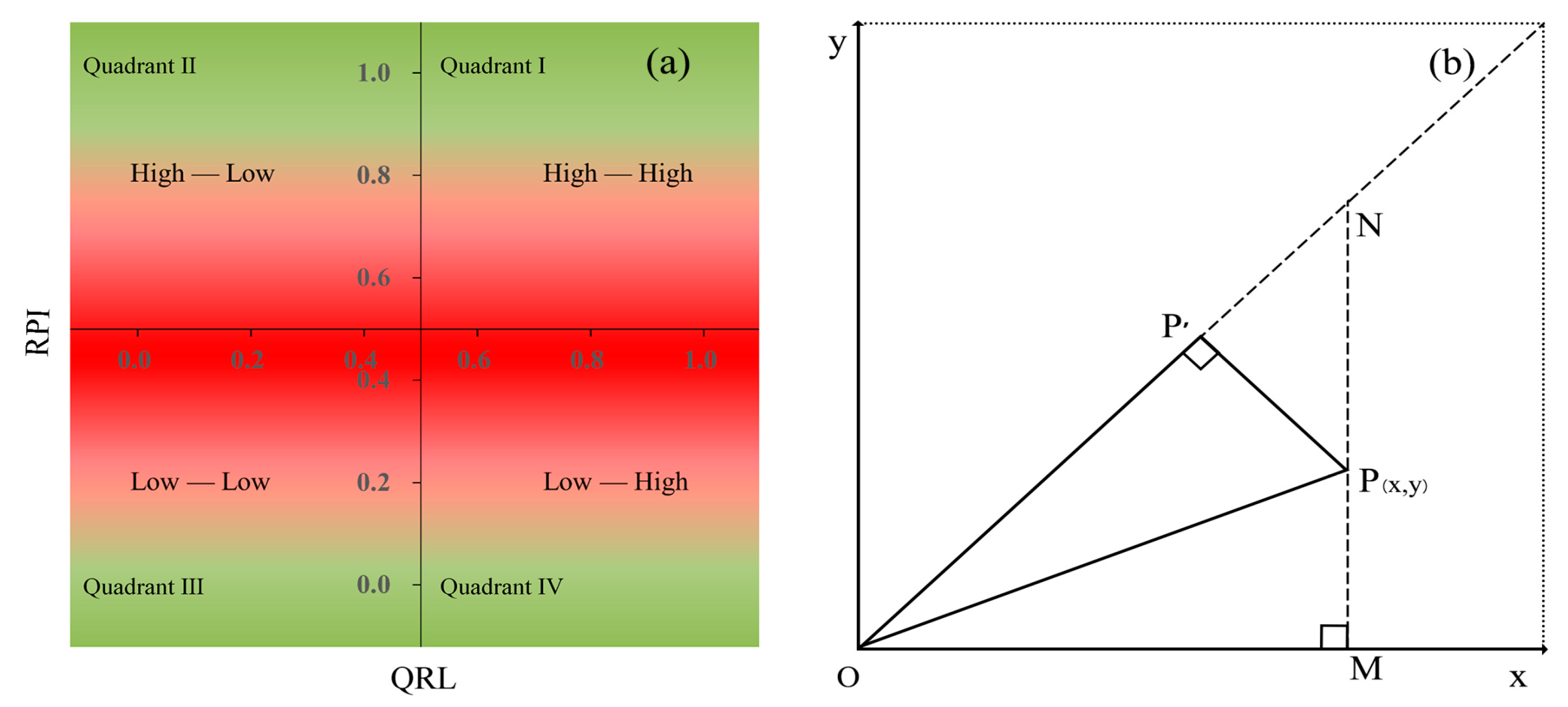
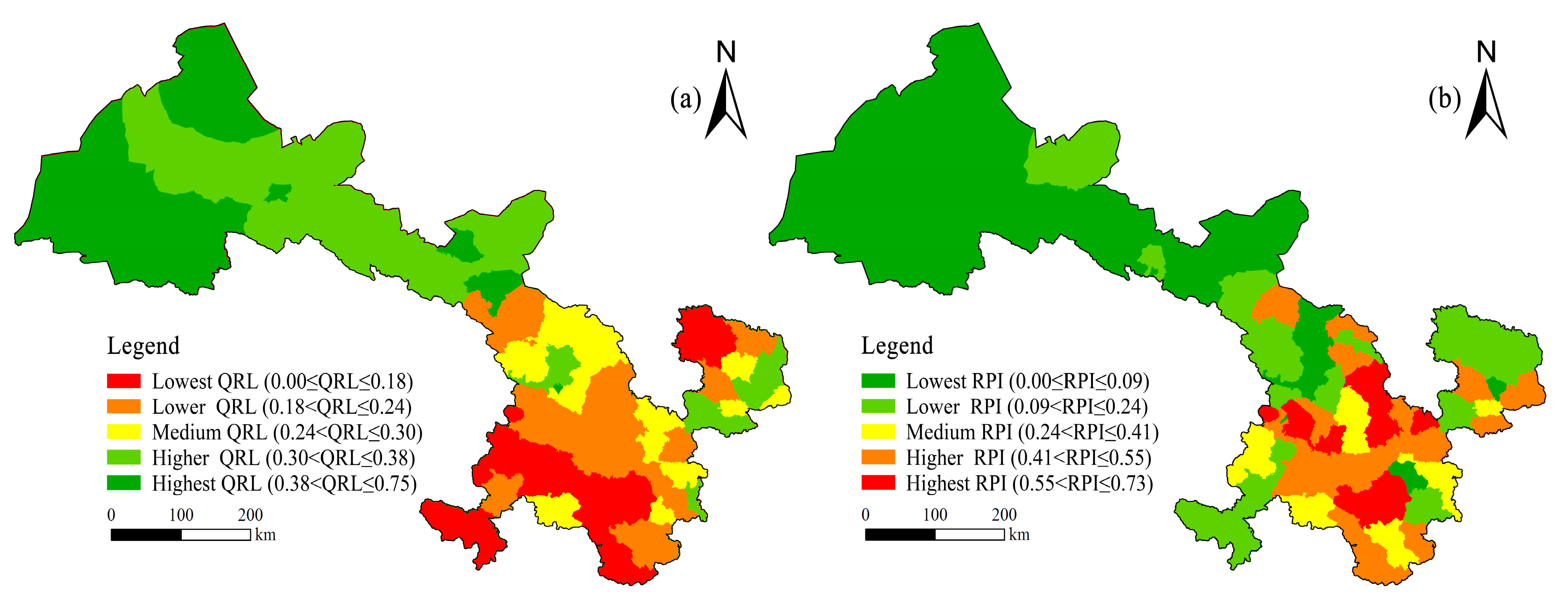
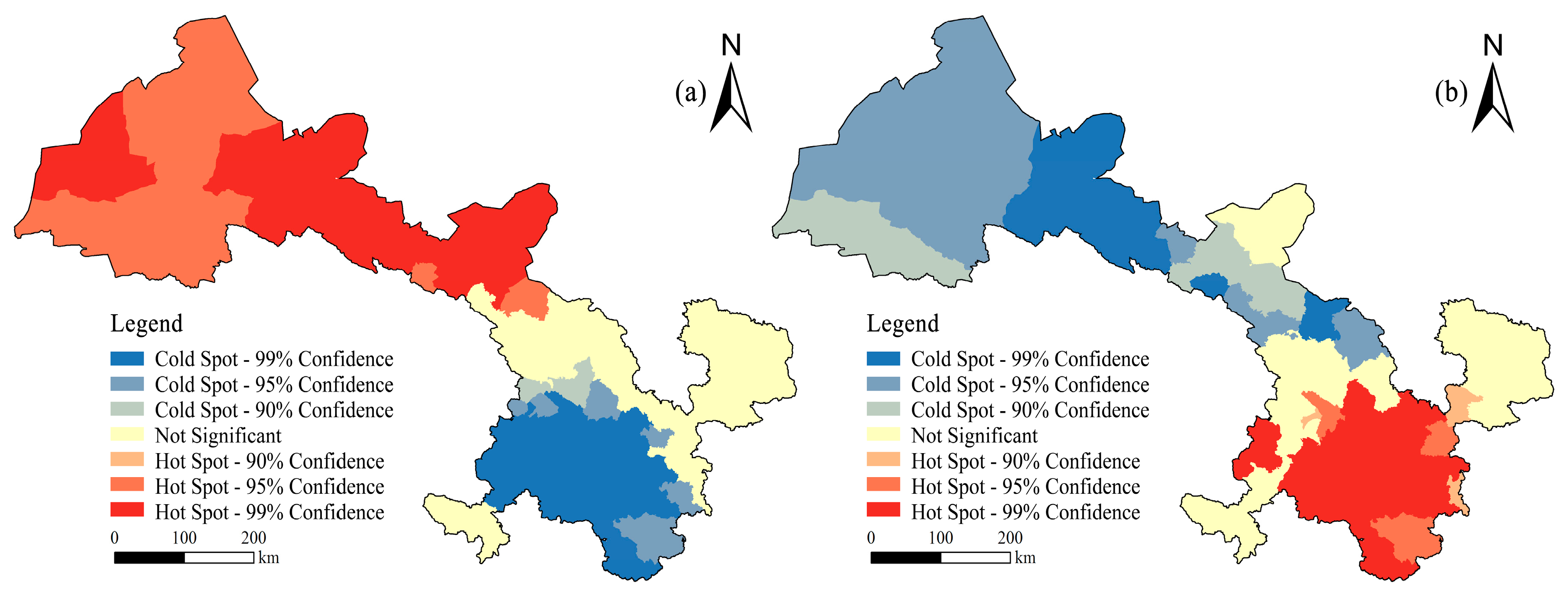
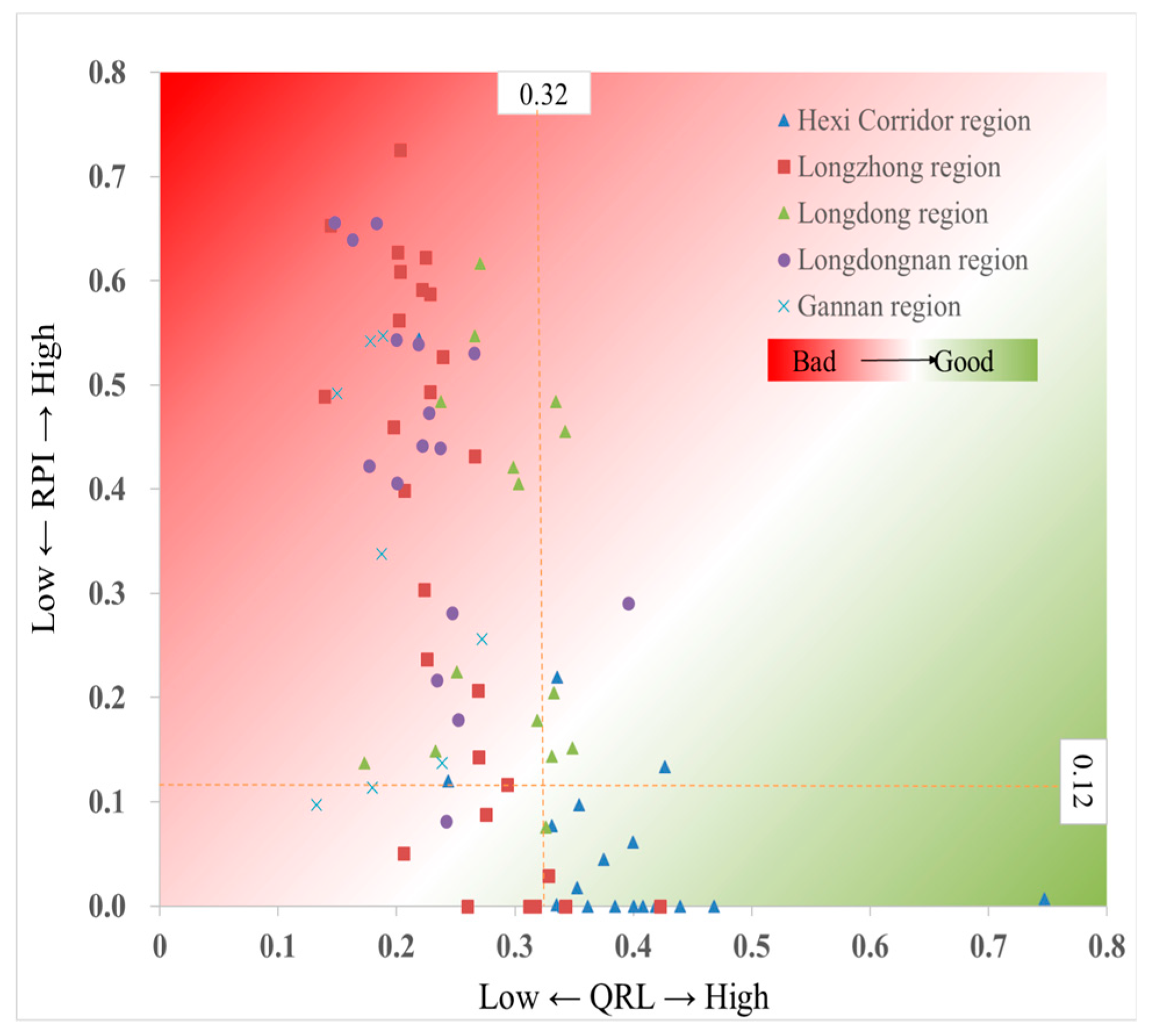

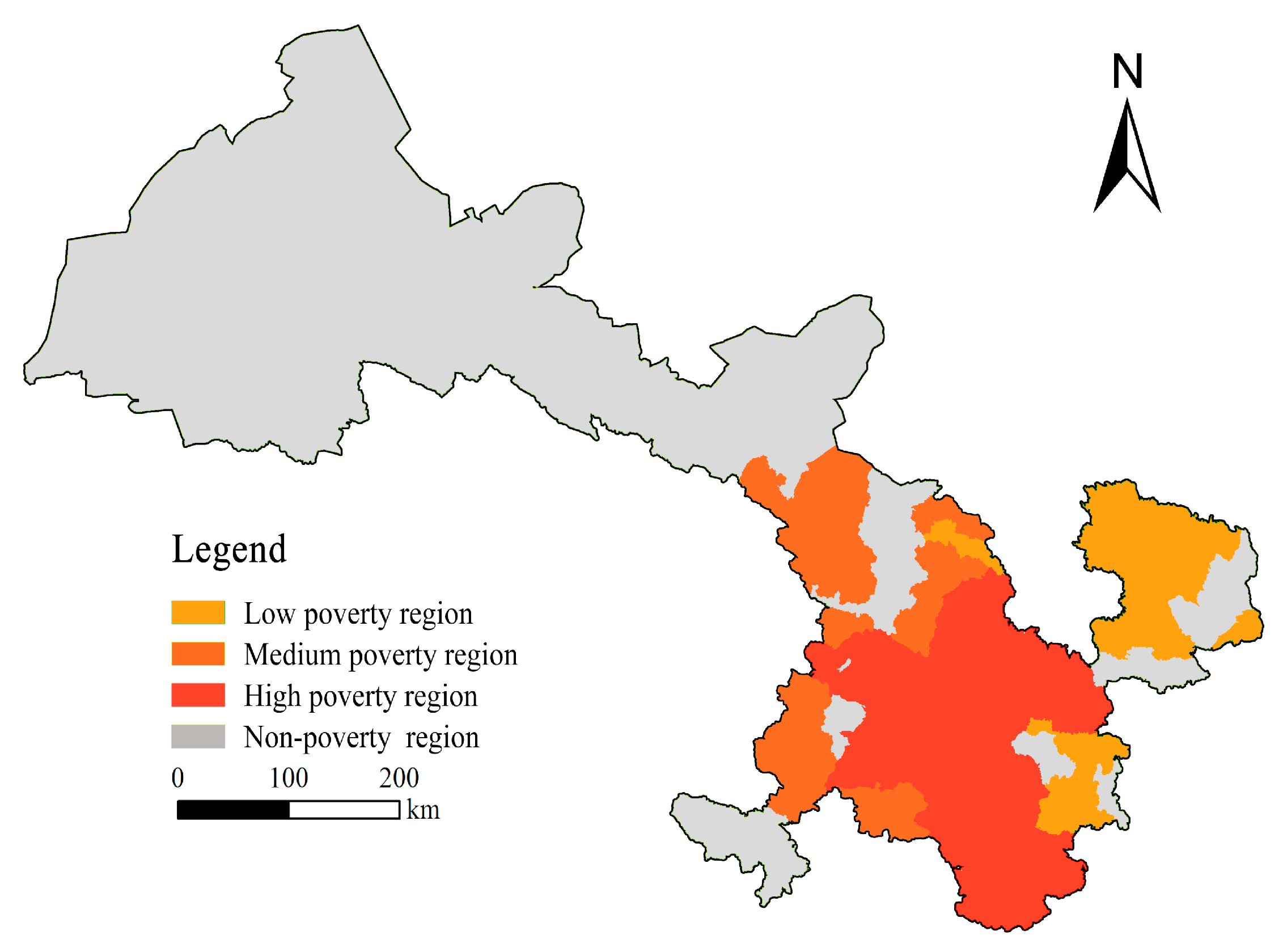
| Item Layer | Index Layer | Index Explanation | Index Weight | The Data Source |
|---|---|---|---|---|
| Income and expenditure B1 (0.1123) | Per capita disposable income of rural residents Z1 (Yuan) | Income earned by rural households after initial and redistribution | 0.0564 | Gansu Province Rural Yearbook 2017 |
| Per capita consumption expenditure of rural residents Z2 (Yuan) | Total expenditure of rural residents to meet household consumption in daily life | 0.0491 | Gansu Province Rural Yearbook 2017 | |
| Engel′s coefficient of rural residents Z3 (%) | The proportion of total food expenditure of rural residents to total personal consumption expenditure | 0.0271 | Gansu Province Development Yearbook 2017 | |
| Ratio of urban to rural per capita disposable income Z4 (%) | The ratio of urban residents’ disposable income to rural residents’ disposable income | 0.0244 | Gansu Province Development Yearbook 2017 | |
| Living conditions and cultural life B2 (0.2238) | Per capita housing area of rural residents Z5 (m2/person) | Average housing area per person owned by rural residents | 0.0483 | China Rural Yearbook 2017 |
| Proportion of cultural entertainment and education expenditure in household consumption expenditure Z6 (%) | An important indicator to reflect the change of rural residents’ consumption structure | 0.0296 | China Rural Yearbook 2017 | |
| Infrastructure B3 (0.1836) | Electricity consumption per 10,000 households Z7 (km·h) | Electricity consumption for social life | 0.0644 | Gansu Province Development Yearbook 2017 |
| Tap water usage in rural areas Z8 (%) | Average level of popularity and convenience of rural water supply | 0.0194 | Gansu Province Development Yearbook 2017 | |
| Access rate of public transportation lines in rural areas Z9 (%) | Coverage Level of Public Transport Team in Rural Areas | 0.0362 | Gansu Province Rural Yearbook 2017 | |
| Rural broadband coverage Z10 (%) | Response to the level of rural informatization | 0.031 | Gansu Province Rural Yearbook 2017 | |
| Agricultural mechanization rate Z11 (%) | Indicators for evaluating the utilization of machinery in agricultural production | 0.0369 | Gansu Province Rural Yearbook 2017 | |
| Agricultural technology popularization rate Z12 (%) | Popularization of scientific and technological achievements and practical technologies in agricultural production | 0.0136 | China Rural Yearbook 2017 | |
| Rural cable television popularization rate Z13 (%) | Response to the level of rural informatization | 0.0525 | Gansu Province Development Yearbook 2017 | |
| Public services and social security B4 (0.1186) | The number of teachers per 1000 people Z14 | Reflecting the development level of rural education | 0.0374 | Gansu Province Rural Yearbook 2017 |
| Rate of participation in new rural cooperative medical system Z15 (%) | Reflecting the level of medical assistance in rural areas | 0.0673 | Gansu Province Rural Yearbook 2017 | |
| Number of hospital beds per 1000 people Z16 | Response to the level of rural medical and health facilities | 0.1699 | Gansu Province Development Yearbook 2017 | |
| Proportion of health care expenditure in household consumption expenditure Z17 (%) | Reflect the proportion of rural medical and health expenditure in the total consumption expenditure | 0.0456 | China Statistical Yearbook 2017 | |
| Proportion of rural laborers with a high school degree or higher Z18 (%) | Reflecting the education level of rural employees | 0.0421 | Gansu Province Rural Yearbook 2017 | |
| Ecological environment B5 (0.3618) | Rate of centralized treatment of rural domestic garbage Z19 (%) | Popularization of centralized waste disposal in rural areas | 0.0261 | Gansu Province Rural Yearbook 2017 |
| Rate of centralized treatment of sewage Z20 (%) | Popularity of rural waste sewage treatment | 0.0921 | China Statistical Yearbook 2017 | |
| Forest coverage Z21 (%) | The proportion of forest area to total land area. | 0.0304 | Gansu Province Rural Yearbook 2017 |
| Item Layer | Index Layer | Maximum | Minimum | Average | Standard Deviation |
|---|---|---|---|---|---|
| B1 | Z1 | 22,879.070 | 4496.620 | 8951.239 | 4067.423 |
| Z2 | 20,876.730 | 3590.000 | 8004.559 | 3509.479 | |
| Z3 | 0.471 | 0.206 | 0.353 | 0.052 | |
| Z4 | 0.680 | 0.240 | 0.380 | 0.119 | |
| B2 | Z5 | 173.880 | 7.050 | 34.658 | 21.597 |
| Z6 | 0.200 | 0.010 | 0.098 | 0.042 | |
| B3 | Z7 | 42,956.000 | 104.080 | 5573.376 | 5704.964 |
| Z8 | 1.160 | 0.000 | 0.788 | 0.247 | |
| Z9 | 1.000 | 0.000 | 0.619 | 0.363 | |
| Z10 | 1.000 | 0.000 | 0.644 | 0.323 | |
| Z11 | 115.830 | 44.760 | 67.983 | 13.883 | |
| Z12 | 1.000 | 0.950 | 0.993 | 0.010 | |
| Z13 | 14.290 | 0.000 | 3.178 | 2.701 | |
| B4 | Z14 | 0.340 | 0.010 | 0.087 | 0.047 |
| Z15 | 1.000 | 0.000 | 0.225 | 0.246 | |
| Z16 | 0.560 | 0.000 | 0.024 | 0.067 | |
| Z17 | 0.740 | 0.030 | 0.246 | 0.159 | |
| Z18 | 1.000 | 0.000 | 0.476 | 0.324 | |
| B5 | Z19 | 100.000 | 0.000 | 60.918 | 25.736 |
| Z20 | 0.014 | 0.000 | 0.002 | 0.002 | |
| Z21 | 0.380 | 0.040 | 0.171 | 0.064 |
| IPA Quadrants | Hexi Corridor Region | Long zhong Region | Long dong Region | Long dong nan Region | Gan nan Region | In Total |
|---|---|---|---|---|---|---|
| High QRL–High RPI | 2 | 0 | 5 | 1 | 0 | 8 |
| Low QRL–High RPI | 2 | 19 | 9 | 14 | 6 | 50 |
| Low QRL–Low RPI | 0 | 5 | 0 | 1 | 2 | 8 |
| High QRL–Low RPI | 16 | 4 | 1 | 0 | 0 | 21 |
| In total | 20 | 28 | 15 | 16 | 8 | 87 |
© 2019 by the authors. Licensee MDPI, Basel, Switzerland. This article is an open access article distributed under the terms and conditions of the Creative Commons Attribution (CC BY) license (http://creativecommons.org/licenses/by/4.0/).
Share and Cite
Ma, L.; Che, X.; Zhang, J.; Fang, F.; Chen, M. Rural Poverty Identification and Comprehensive Poverty Assessment Based on Quality-of-Life: The Case of Gansu Province (China). Sustainability 2019, 11, 4547. https://doi.org/10.3390/su11174547
Ma L, Che X, Zhang J, Fang F, Chen M. Rural Poverty Identification and Comprehensive Poverty Assessment Based on Quality-of-Life: The Case of Gansu Province (China). Sustainability. 2019; 11(17):4547. https://doi.org/10.3390/su11174547
Chicago/Turabian StyleMa, Libang, Xinglong Che, Junhui Zhang, Fang Fang, and Meimei Chen. 2019. "Rural Poverty Identification and Comprehensive Poverty Assessment Based on Quality-of-Life: The Case of Gansu Province (China)" Sustainability 11, no. 17: 4547. https://doi.org/10.3390/su11174547
APA StyleMa, L., Che, X., Zhang, J., Fang, F., & Chen, M. (2019). Rural Poverty Identification and Comprehensive Poverty Assessment Based on Quality-of-Life: The Case of Gansu Province (China). Sustainability, 11(17), 4547. https://doi.org/10.3390/su11174547






